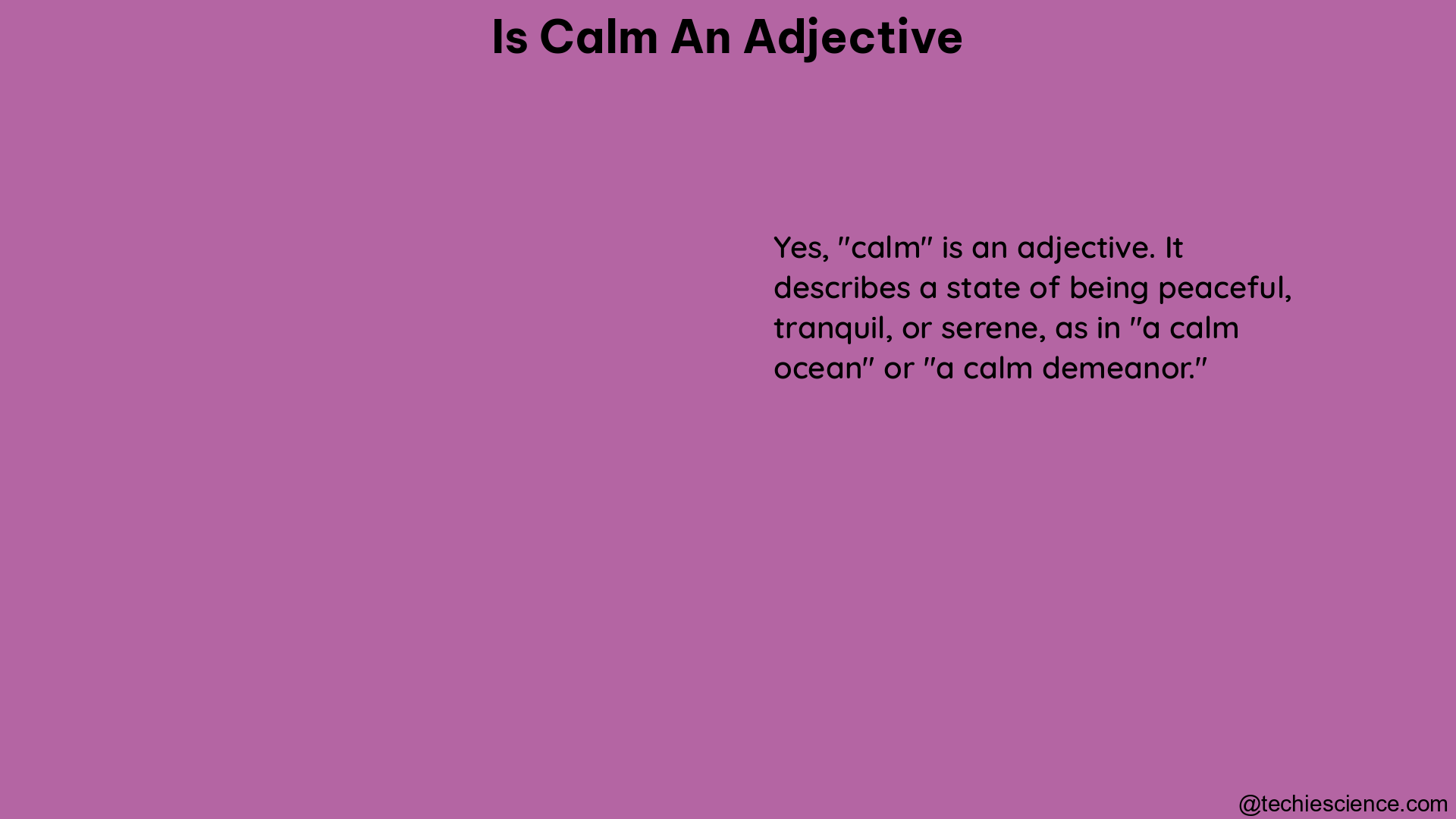Yes, “calm” can be an adjective. As an adjective, “calm” describes a state or condition characterized by a lack of agitation, disturbance, or excitement. It can be used to describe both physical and emotional states.
Understanding the Adjective “Calm”
Definition of Adjective
An adjective is a word that modifies or describes a noun or pronoun. Adjectives provide additional information about the noun, such as its size, color, quality, or state.
Characteristics of the Adjective “Calm”
The adjective “calm” has the following characteristics:
- Lack of Agitation or Disturbance: When something is described as “calm,” it suggests a state of tranquility, serenity, and absence of turbulence or disruption.
- Emotional Composure: The adjective “calm” can be used to describe a person’s emotional state, indicating a sense of control, poise, and equanimity, even in the face of challenging situations.
- Physical Stillness: “Calm” can also describe the physical environment, such as a calm sea, a calm breeze, or a calm atmosphere, where there is a lack of movement or disturbance.
- Soothing and Relaxing: The adjective “calm” often evokes a sense of peacefulness, relaxation, and a feeling of being at ease.
Examples of “Calm” as an Adjective
Here are some examples of how the adjective “calm” can be used:
- The calm waters of the lake reflected the surrounding trees.
- She remained calm and collected during the intense job interview.
- The calm demeanor of the yoga instructor helped the students relax.
- The calm atmosphere in the library allowed me to focus on my studies.
- The calm breeze gently rustled the leaves of the trees.
In these examples, the adjective “calm” is used to describe the physical characteristics of the water, the emotional state of a person, the demeanor of an individual, the atmosphere of a place, and the movement of the wind. In each case, “calm” conveys a sense of tranquility, composure, and a lack of disturbance or agitation.
Grammatical Functions of “Calm” as an Adjective

Attributive Adjective
As an attributive adjective, “calm” is placed before the noun it modifies, providing a direct description of the noun.
Example: The calm ocean waves lapped against the shore.
Predicative Adjective
In the predicative position, “calm” follows the noun or pronoun it describes, often linked by a verb such as “to be” or “to remain.”
Example: The ocean waves were calm today.
Comparative and Superlative Forms
The adjective “calm” can also take comparative and superlative forms to indicate degrees of calmness.
Comparative form: The lake was calmer than the river.
Superlative form: The mountain top offered the calmest view in the region.
Adverbial Use of “Calm”
In some cases, “calm” can be used as an adverb to describe the manner in which an action is performed.
Example: She spoke calmly to the upset customer.
In this instance, “calmly” modifies the verb “spoke,” indicating the manner in which the action was carried out.
Synonyms and Antonyms of “Calm”
Synonyms of “Calm”
Some synonyms of the adjective “calm” include:
- Serene
- Tranquil
- Peaceful
- Composed
- Collected
- Unruffled
- Placid
- Undisturbed
- Relaxed
- Soothing
These synonyms all convey a similar sense of calmness, serenity, and a lack of agitation or disturbance.
Antonyms of “Calm”
Conversely, the antonyms of “calm” include:
- Agitated
- Turbulent
- Chaotic
- Frenzied
- Restless
- Anxious
- Disturbed
- Flustered
- Frantic
- Uneasy
These antonyms describe the opposite of a calm state, suggesting a sense of unrest, disturbance, and a lack of composure or tranquility.
Usage of “Calm” in Sentences
Here are some additional examples of how the adjective “calm” can be used in sentences:
- The calm demeanor of the therapist helped the patient feel at ease during the session.
- The calm surface of the lake belied the strong currents beneath.
- Despite the chaos around her, she maintained a calm and focused attitude.
- The calm breeze and the sound of the waves created a soothing ambiance at the beach.
- The calm expression on the child’s face indicated that they were not upset by the situation.
- The calm tone of the instructor’s voice helped the students feel more relaxed during the yoga class.
- The calm and collected manner in which the firefighters handled the emergency situation was admirable.
- The calm and serene environment of the meditation retreat allowed participants to find inner peace.
- The calm and steady rhythm of the heartbeat was a reassuring sign during the medical examination.
- The calm and rational approach of the negotiator helped to de-escalate the tense situation.
In each of these examples, the adjective “calm” is used to describe a specific aspect of the subject, whether it’s a person’s demeanor, the physical environment, or the overall atmosphere of a situation. The use of “calm” conveys a sense of tranquility, composure, and a lack of disturbance or agitation.
Conclusion
In summary, “calm” is undoubtedly an adjective that can be used to describe a wide range of physical and emotional states. It conveys a sense of tranquility, serenity, and a lack of agitation or disturbance. Understanding the characteristics, grammatical functions, and usage of the adjective “calm” can help writers and speakers effectively convey the desired tone and atmosphere in their communication.
Reference:
– Merriam-Webster Dictionary – Calm
– Oxford English Dictionary – Calm
– Grammarly – Adjectives
Hey! I am Arpita Bose Roy. My qualifications are M.A. in English with B. Ed. in both general education and special education. I have 2 years of experience as a “language analyst” at IIT Kharagpur and 4 years of experience as an “Academic Content Developer” at IIT Kharagpur. Currently, I am working as an academic writer at Lambdageeks.